Terraforming Mars
A huge variety of cards and a myriad of ways to chain them into powerful engines is the heart of Terraforming Mars, and this is what makes it into such an enjoyable game with high replay value.
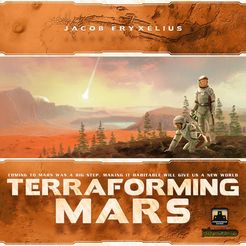
Posted 18 May 2019 by Callan Bond
- Card Drafting
- Games we LOVE
- Hand Management
- Sci-Fi
- Set Collection
- Terraforming Mars
- Tile placement
- Variable Player Powers
- Designer(s): Jacob Fryxelius
- Publisher: Stronghold Games
- Playercount: 1-4, more with expansions
- Length: 90 - 120 min
Intro
A huge variety of cards and a myriad of ways to chain them into powerful engines is the heart of Terraforming Mars, and this is what makes it into such an enjoyable game with high replay value. Here follows a review of Terraforming Mars board game and Terraforming Mars rules.
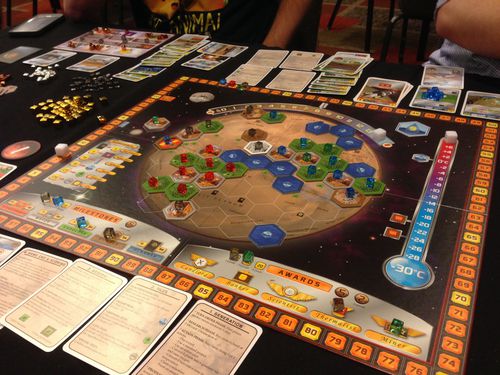
Overview of Gameplay
Each player is a corporation working to terraform the planet. The game ends when the three conditions needed to make Mars liveable are reached: raising the mean temperature from -30C to 8C, having 9% of the surface covered in oceans, and raising oxygen from 0% of the atmosphere to 14%. Players play cards and lay tiles on the planet's surface to raise each of these attributes, and score VP along the way. The game ends when all three of these conditions are met.
Players either start with a beginning Corporation which gives 42 credits and 10 cards or if they are an experienced player, 'take 2 and choose 1' advanced corporation. Each advanced corporation gives some kind of extra ability such as a discount on playing certain kinds of cards, or rewards when other players take certain actions. The difference is the advanced corporations must pay 3 credits for each of their starting cards, so in effect, the beginner corporation starts with a 'bonus' 30 credits (10 cards x 3 credits each) worth of cards in their hand- but no extra ability. The rules recommend new players always take the beginner corporation, as they give a good bonus without having to know which specialization paths may work well.
Each player has a mat in front of them with numerous resource areas: credits (money), steel, titanium, plants, electricity, and heat. Each resource area has a track for production of the resource, and an area to store the actual resource cubes themselves. Production of resources occur at the end of each round ('generation'), and the cubes go into the storage area for that resource.
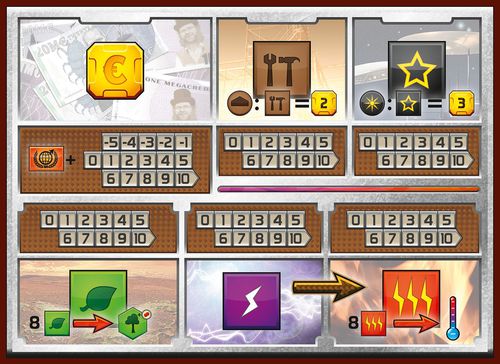
Money is used to pay the cost of cards. Steel is also used to pay for cards, but can only be played on cards that have a 'building' tag. However, each steel counts as 2 credits instead of 1, so a high steel production allows more building cards to be played easily. Titanium is like steel, except worth 3 credits each, but can only be used on cards with a 'space' tag. Plants are used to make greenery tiles. Electricity is used for certain cards and at the end of every round unused electricity is converted into heat. Heat is used to raise the planet's temperature.
Whenever a global parameter (oxygen level, planet temperature, or ocean tile) is played, the player increases one 'TR' which is Terraforming Rating. TR provides two benefits: first, it counts as money production. So at the end of a round during production, players receive credits equal to their player mat money production, PLUS their TR rating. Secondly, each TR is worth one VP at the end of the game. Players start with 20 TR.
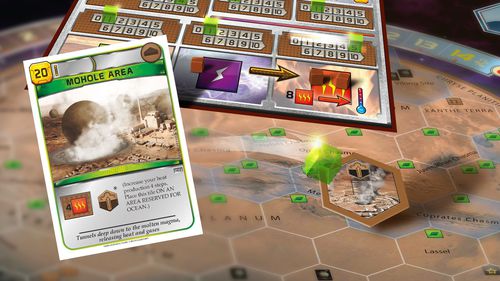
Each round, players take turns taking 1 or 2 actions. Once a player takes no action and passes, they are out of the round until all players pass. On a player's turn they may play a card from their hand, claim a milestone or unlock an award, take a 'standard action' on the board, or play resources to either raise the temperature by one degree or make a greenery tile, which raises oxygen by 1% when played.
Playing cards are the heart of the game. Each card has a cost and many have prerequisites, such as a minimum planet oxygen level before the card can be played. Some cards have maximum limits as well, such as the temperature must be below a certain threshold (e.g., the temperature must be lower than -12C). If a player has this card and wants to play it, they must time the play as these cards become effectively useless once the threshold limit is passed.
Some cards make resources not on the mat but are created and stored on cards. These may be things like animals, bacteria, or space fighters. Cards that make and use these specialized resources are an opportunity to create 'mini-engines' that provide VP or other bonuses.
Standard actions allow players to do certain actions without cards. Generally, these are 'overpaying' for actions that can be done cheaper with a card, but they don't require the card (and the associated money to acquire it). Examples are; Increase electricity generation by one, raise the temperature by one, or build a city. One important standard action is the ability to sell cards from your hand for 1 credit each.
Claiming a Milestone allows players to earn 5 VP if they are the first player to reach a certain threshold: have 35 'TR', have 3 cities, have 3 greenery tiles, have 8 cards played with building tags, or have 16 cards in their hand. To claim a milestone a player pays 8 resources and locks it with their cube: they are now guaranteed these 5 VP at the end of the game. Only 3 of the 5 milestones can be claimed every game, so this turns into a bit of a race to grab them.
Unlocking Awards works similarly, except players are not guaranteed to receive the bonus. Instead, a player pays a cost to 'unlock' an award: one which they think they are of course going to win at the end of the game. The awards are: most tiles played on the board, most heat cubes, most steel and titanium cubes (combined), most money production, and most cards with science tags played. Only three awards can be unlocked, and they become progressively more expensive to unlock. At the end of the game, whoever is the leader in the category gets 5 VP, and second place gets 2 VP- so it is quite possible that the person who unlocked the award does not take first place.
Players can also as an action pay eight heat resources to raise the temperature one step (2C), or pay 8 plant resources to place a greenery tile. Placing greenery tiles raise the oxygen by 1%. Greenery tiles must be placed adjacent to any tile on the board the player already has ownership of. If there are none the greenery tile can be placed anywhere.
Oceans are placed generally from cards (or from a standard action) and must be placed on a designated 'blue' tile. Placing any tile also gives any printed reward underneath it, such as plant, steel, or cards. Players do not claim ownership of oceans, but placing one does raise the global parameter for oceans by one, and there are nine ocean tiles in total that must be played. Any tile subsequently placed next to an ocean tile gives the player placing the new tile a two-credit bonus.
Remember - increasing any of the three global parameters (including oceans) also results in a TR increase which provides both money production and VP at the end of the game. Once any of these global parameters are maxed, there is no longer any TR reward if they happen to be increased again through a card action: that part of the effect is essentially ignored.
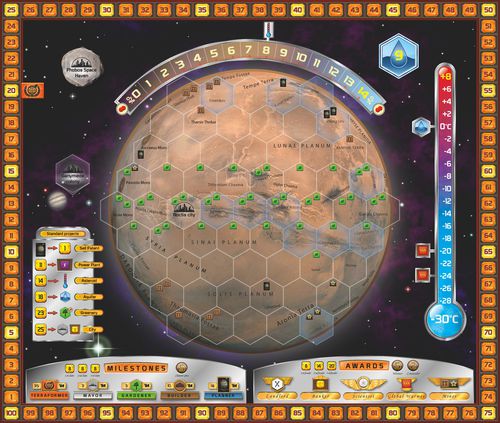
At the end of the round production occurs, and then each player receives four new cards. In the base version of the game, players choose which of these cards they want to add to their hand for 3 credits each. There is a draft variant where players still start with four cards, but then draft them around the table alternating passing left or right round to round.
Once all three global parameters are filled, players complete that final round. VP are awarded based on TR rating, awards and milestones, VP on any cards that have been played, and tiles placed on the board. Greenery tiles are worth 1 VP for each of their owners, and city tiles are worth 1 VP for each adjacent greenery tile (regardless of owner) that they have. The player with the most VPs wins.
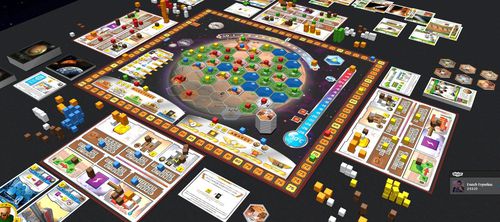
Opinion
I've played Terraforming Mars the board game five times now with 3 - 5 players. It's fantastic. The game scales extremely well and because it ends not after a set number of rounds but when the global parameters are all reached, it seems to roughly take the same amount of time (two to two and a half hours). Each game has been very different: in some, the planet tiles have filled up quickly, in others very little development until the end. I've had all three of the different global parameters max out early depending on the play, so in one game oxygen maxed very early, in another, it might be oceans, and another heat. Conversely, the final parameter to get maxed can vary just as easily.
I love the theme of this game. Clearly the designers "know their Mars", and it's almost quasi-educational learning even from the rulebook on why the global parameter targets are set to what they are set. Short version: these really are the minimum targets humanity would need to make Mars livable. Everything ties together nicely, and the hundreds of unique cards also seem grounded in reality for things that would occur over the hundreds of years needed to terraform the planet.
Player's strategies obviously change depending on the cards they get. After you play one beginner game, in my opinion, card drafting is essential. It makes going for a particular strategy much more feasible. In the standard game, you only draw four cards each round and it is very possible not to get any of a certain type of card, or only to get a broad spread of everything and not have any good combos appear. Drafting effectively mitigates this.
There are a good number of cards that affect other players, but not enough that it feels like a player can be ruined by 'take that' cards. Most cards in the base version that affect other players cause them to lose plant resources, so players learn to spend these quickly as soon as they have eight accumulated.
The engine building in this game is stellar. There is a very satisfying sense of progression in going from scraping together enough to play one or two cards per round, to being able to easily play multiple high-cost cards later in the game as you leverage your steel and titanium production in addition to your increased money generation. The global parameters tend to be stagnant or creep up very slowly in the first hour of gameplay, but towards the end, they can rocket up quickly resulting in races to boost them and get the associated TR bonus before they are maxed out.
There is a separate set of advanced cards that I used for the first time yesterday. These definitely add to the game length, I went from an average of 2-2.5 hours to around 3.5 yesterday and all three of us had played before. These cards also offer a much broader variety of 'take that' (although still not overwhelming or too punishing). The game also takes longer because when using them, each player starts with a production of '0' for each resource rather than '1' in the base game.
The components are overall very good. The board is excellent and looks visually appealing given how dry it could have been. The shiny resource cubes, while nice, have started to chip on the corners, especially the bronze ones. My big complaint though from a component perspective is the player mats. They're very flimsy, and also glossy so the cubes move all over the place on a slight bump. This is an issue especially given how easy you can lose track of your resource production. Thicker mats with a linen finish would have been more appropriate here, especially given the MSRP of the game.
Minor quibbles on the mats aside, Terraforming Mars board game is an absolute winner. It's got an awesome theme that works, huge replayability, satisfying engine building, and juicy choices throughout the game. Highly recommended.
Rating: 10/10
Terraforming Mars review by guest-star Callan Bond (calbond @ BGG), thanks a lot!
By the way, you should sleeve your Terraforming Mars cards.
Files
- Terraforming Mars Rulebook - Terraforming Mars rules pdf format
Pick Terraforming Mars the board game up at your favorite online retailer, it should cost around 45 dollars / 40 euros.
Return to Reviews